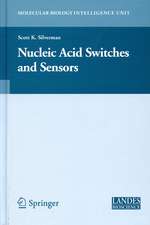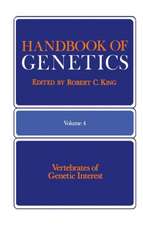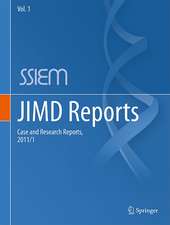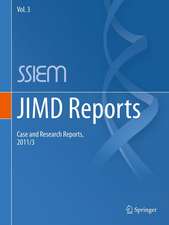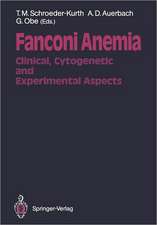Gene Regulation: Methods and Protocols: Methods in Molecular Biology, cartea 977
Editat de Minou Binaen Limba Engleză Paperback – 23 aug 2016
Comprehensive and broad in their scope, the protocols are useful to researchers in many disciplines including molecular biology, genomics, biochemistry, biomedicine, nutrition, and agricultural sciences.
| Toate formatele și edițiile | Preț | Express |
|---|---|---|
| Paperback (1) | 1037.36 lei 6-8 săpt. | |
| Humana Press Inc. – 23 aug 2016 | 1037.36 lei 6-8 săpt. | |
| Hardback (1) | 737.32 lei 6-8 săpt. | |
| Humana Press Inc. – 23 feb 2013 | 737.32 lei 6-8 săpt. |
Din seria Methods in Molecular Biology
- 9%
 Preț: 791.59 lei
Preț: 791.59 lei - 23%
 Preț: 598.56 lei
Preț: 598.56 lei - 20%
 Preț: 882.95 lei
Preț: 882.95 lei -
 Preț: 252.04 lei
Preț: 252.04 lei - 5%
 Preț: 802.69 lei
Preț: 802.69 lei - 5%
 Preț: 729.61 lei
Preț: 729.61 lei - 5%
 Preț: 731.43 lei
Preț: 731.43 lei - 5%
 Preț: 741.30 lei
Preț: 741.30 lei - 5%
 Preț: 747.16 lei
Preț: 747.16 lei - 15%
 Preț: 663.45 lei
Preț: 663.45 lei - 18%
 Preț: 1025.34 lei
Preț: 1025.34 lei - 5%
 Preț: 734.57 lei
Preț: 734.57 lei - 18%
 Preț: 914.20 lei
Preț: 914.20 lei - 15%
 Preț: 664.61 lei
Preț: 664.61 lei - 15%
 Preț: 654.12 lei
Preț: 654.12 lei - 18%
 Preț: 1414.74 lei
Preț: 1414.74 lei - 5%
 Preț: 742.60 lei
Preț: 742.60 lei - 20%
 Preț: 821.63 lei
Preț: 821.63 lei - 18%
 Preț: 972.30 lei
Preț: 972.30 lei - 15%
 Preț: 660.49 lei
Preț: 660.49 lei - 5%
 Preț: 738.41 lei
Preț: 738.41 lei - 18%
 Preț: 984.92 lei
Preț: 984.92 lei - 5%
 Preț: 733.29 lei
Preț: 733.29 lei -
 Preț: 392.58 lei
Preț: 392.58 lei - 5%
 Preț: 746.26 lei
Preț: 746.26 lei - 18%
 Preț: 962.66 lei
Preț: 962.66 lei - 23%
 Preț: 860.21 lei
Preț: 860.21 lei - 15%
 Preț: 652.64 lei
Preț: 652.64 lei - 5%
 Preț: 1055.50 lei
Preț: 1055.50 lei - 23%
 Preț: 883.85 lei
Preț: 883.85 lei - 19%
 Preț: 491.88 lei
Preț: 491.88 lei - 5%
 Preț: 1038.84 lei
Preț: 1038.84 lei - 5%
 Preț: 524.15 lei
Preț: 524.15 lei - 18%
 Preț: 2122.34 lei
Preț: 2122.34 lei - 5%
 Preț: 1299.23 lei
Preț: 1299.23 lei - 5%
 Preț: 1339.10 lei
Preț: 1339.10 lei - 18%
 Preț: 1390.26 lei
Preț: 1390.26 lei - 18%
 Preț: 1395.63 lei
Preț: 1395.63 lei - 18%
 Preț: 1129.65 lei
Preț: 1129.65 lei - 18%
 Preț: 1408.26 lei
Preț: 1408.26 lei - 18%
 Preț: 1124.92 lei
Preț: 1124.92 lei - 18%
 Preț: 966.27 lei
Preț: 966.27 lei - 5%
 Preț: 1299.99 lei
Preț: 1299.99 lei - 5%
 Preț: 1108.51 lei
Preț: 1108.51 lei - 5%
 Preț: 983.72 lei
Preț: 983.72 lei - 5%
 Preț: 728.16 lei
Preț: 728.16 lei - 18%
 Preț: 1118.62 lei
Preț: 1118.62 lei - 18%
 Preț: 955.25 lei
Preț: 955.25 lei - 5%
 Preț: 1035.60 lei
Preț: 1035.60 lei - 18%
 Preț: 1400.35 lei
Preț: 1400.35 lei
Preț: 1037.36 lei
Preț vechi: 1091.96 lei
-5% Nou
Puncte Express: 1556
Preț estimativ în valută:
198.49€ • 207.80$ • 164.24£
198.49€ • 207.80$ • 164.24£
Carte tipărită la comandă
Livrare economică 05-19 aprilie
Preluare comenzi: 021 569.72.76
Specificații
ISBN-13: 9781493962884
ISBN-10: 1493962884
Pagini: 420
Ilustrații: XV, 401 p. 80 illus., 19 illus. in color.
Dimensiuni: 178 x 254 x 22 mm
Greutate: 0.73 kg
Ediția:Softcover reprint of the original 1st ed. 2013
Editura: Humana Press Inc.
Colecția Humana
Seria Methods in Molecular Biology
Locul publicării:Totowa, NJ, United States
ISBN-10: 1493962884
Pagini: 420
Ilustrații: XV, 401 p. 80 illus., 19 illus. in color.
Dimensiuni: 178 x 254 x 22 mm
Greutate: 0.73 kg
Ediția:Softcover reprint of the original 1st ed. 2013
Editura: Humana Press Inc.
Colecția Humana
Seria Methods in Molecular Biology
Locul publicării:Totowa, NJ, United States
Cuprins
Gene Regulation.- Isolation of Nuclei for use in Genome-wide DNase Hypersensitivity Assays to Probe Chromatin Structure.- DNase I Digestion of Isolated Nulcei for Genome-Wide Mapping of DNase Hypersensitivity Sites in Chromatin.- Isolation and Analysis of DNA Derived from Nucleosome-Free Regions.- Acquisition of High Quality DNA for Massive Parallel Sequencing by in vivo Chromatin Immunoprecipitation.- Luciferase Assay to Study the Activity of a Cloned Promoter DNA Fragment.- Promoter Deletion Analysis using a Dual-luciferase Reporter System.- Application of mRNA Display for in vitro Selection of DNA-binding Transcription Factor Complexes.- Isolation of Intracellular Protein:DNA Complexes using HaloCHIP; An Antibody Free Alternative to Chromatin Immunoprecipitation.- A Modified Yeast One-Hybrid System for Genome Wide Identification of Transcription Factor Binding Sites.- Identifying Specific Protein--DNA Interactions using SILAC--based Quantitative Proteomics.- Electrophoretic Mobility-Shift and Super-Shift Assays for Studies and Characterization of Protein-DNA Complexes.- Combination of Native and Denaturing PAGE for the Detection of Protein Binding Regions in Long Fragments of Genomic DNA.- Quantitative NanoProteomics Approach for Protein Complex (QNanoPX) using Gold Nanoparticle-based DNA Probe.- Chromatin Assembly and In Vitro Transcription Analyses for Evaluation of Individual Protein Activities in Multicomponent Transcriptional Complexes.- Using FRET to Monitor Protein-induced DNA Bending: The TBP-TATA Complex as a Model System.- Promoter Independent Abortive Transcription Assays Unravel Functional Interactions Between TFIIB and RNA Polymerase.- Fluorescence Cross-correlation Spectroscopy (FCCS) to Observe Dimerization of Transcription Factors in Living Cells.- Nuclear Recruitment Assay as a Tool to validate Transcription Factor Interactions in Mammalian Cells.- Preparation of Cell Lines for Single-Cell Analysis of TranscriptionalActivation Dynamics.- Peptide Microarrays for Profiling of Serine/threonine Kinase Activity of Recombinant Kinases and Lysates of Cells and Tissue Samples.- Immunoaffinity Purification of Protein Complexes from Mammalian Cells.- Simple and Efficient Identification of Chromatin Modifying Complexes and Characterization of Complex Composition.- Heavy Methyl-SILAC Labeling Coupled with Liquid Chromatography and High-resolution Mass Spectrometry to Study the Dynamics of Site-specific Histone Methylation.- Analysis of p300 Occupancy at the Early Stage of Stem Cell Differentiation by Chromatin Immunoprecipitation.- Mammalian Two-Hybrid Assays for Studies of Interaction of p300 with Transcription Factors.- Fluorescence Anisotropy Microplate Assay to Investigate the Interaction of Full-length Steroid Receptor Coactivator-1a with Steroid Receptors.- Use of Histone Deacetylase Inhibitors to Examine the Roles of Bromodomain and Histone Acetylation in p300-dependent Gene Expression.- Histone Deacetylases Valproic Acid as a Small Molecule Inducer to Direct the Differentiation of Pluripotent Stem Cells.- Sedimentation and Immunoprecipitation Assays for Analyzing Complexes that Repress Transcription.- Methods for Studies of Protein Interactions with Different DNA Methyltransferases.
Textul de pe ultima copertă
In this volume of Methods in Molecular Biology™, expert investigators offer comprehensive, complementary, and cutting-edge technologies for studies of gene regulation. The chapters of Gene Regulation: Methods and Protocols are organized to provide an integrated and a coherent view of control systems and their associated components. The protocols are broad in their scope. They include molecular, biochemical, spectroscopic techniques as well as high throughput strategies. Written in the highly successful Methods in Molecular Biology™ series format, chapters include introductions to their respective topics, lists of the necessary materials and reagents, step-by-step, readily reproducible laboratory protocols, and key tips on troubleshooting and avoiding known pitfalls.
Comprehensive and broad in their scope, the protocols are useful to researchers in many disciplines including molecular biology, genomics, biochemistry, biomedicine, nutrition, and agricultural sciences.
FEATURES
• Techniques for studying chromatin structural features that influence gene activation
• In vivo and in vitro assays
• Spectroscopic techniques
• Technologies for examining genome-wide association of transcription factors with regulatory regions of genes
• Proteomics based on SILAC (Stable Isotope Labeling of Amino Acids in Cell Culture)
• Peptide microarray technology for studies of kinases
• Schemes for isolation and characterization of relatively large multiprotein complexes
• Biochemical and biophysical techniques for examining gene repression
• In vitro chromatin reconstitution to investigate multicomponent transcriptional complexes
• Nuclear recruitment assay to validate transcription factor interactions in mammalian cells
Comprehensive and broad in their scope, the protocols are useful to researchers in many disciplines including molecular biology, genomics, biochemistry, biomedicine, nutrition, and agricultural sciences.
FEATURES
• Techniques for studying chromatin structural features that influence gene activation
• In vivo and in vitro assays
• Spectroscopic techniques
• Technologies for examining genome-wide association of transcription factors with regulatory regions of genes
• Proteomics based on SILAC (Stable Isotope Labeling of Amino Acids in Cell Culture)
• Peptide microarray technology for studies of kinases
• Schemes for isolation and characterization of relatively large multiprotein complexes
• Biochemical and biophysical techniques for examining gene repression
• In vitro chromatin reconstitution to investigate multicomponent transcriptional complexes
• Nuclear recruitment assay to validate transcription factor interactions in mammalian cells
Caracteristici
Comprehensive and broad in their scope, the protocols are useful to researchers in many disciplines Provides step-by-step detail essential for reproducible results Contains key notes and implementation advice from the experts Includes supplementary material: sn.pub/extras






